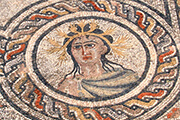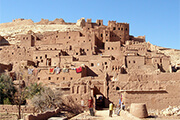Archaeological Site of Lixus

Location
Lixus is located in immediate proximity to the current northern city of Larache. It is commonly called tshommesh by the local population, and is one of the richest and well preserved sites from the classical times in Morocco.
This site was recognized by Heinrich Barth in 1845 and was excavated more than a century later. Indeed, the first excavation were in 1949. Since then, teams from Morocco, France and Spain collaborated in uncovering the bountiful remains of the Roman colony.
Foundation and Roman Occupation
As with every site humans occupy, the reasons are its nearby resources and the wealth that can be easily brought to it and protected within it. Lixus was found by the Phoenicians as they established their counters in the western Mediterranean in the sixth century before J. -C. During the centuries preceding the Roman rule, the local populations were under the influence of the Phoenician, and later Carthaginian culture. This is attested in their life style and the remains found on the site.
In the year 40 J. -C. , Tingitania Mauretania was officially annexed to Rome, and Lixus was one of the five colonies held by it. In the following centuries much of Lixus was built in the image of luxurious Roman cities. Most of what was built then is still buried underground and is very promising of an economically prosperous city. Indeed, the constructions unveiled today are of exceptional excellence in techniques and Aestheticism. Lixus was a successful industrial city in its production of salts and garum (a fish sauce famous in Roman cuisine). Its inhabitants lived an ostentatious lifestyle, if we trust the three Roman houses excavated and the beautiful mosaïcs they delivered. Today, you can admire these mosaïcs in the museum of Tetouan. They represent both black and white and polychrome geometric motifs bearing representations of Gods and of animals (ex : a rooster.) These mosaïcs date back to the second century J. -C. These houses include private bathhouses and a hexagonal pool. A number of temples for different divinities were uncovered in Lixus as well. All of these buildings and more were protected by a big urban city wall.
One of the most important findings in Lixus is first of its kind and unique in the African continent. Moreover, it is one of the few theater-amphitheaters in the classical world. This complex includes a circular arena, a raised podium, a theater, and a cavea to receive the audience. The complex was founded in the beginning of the first century J. -C.
Fall of the Roman Occupation and Islamisation
In the year 285, when Rome deserted the rest of Tingitania Mauretania, it decided to stay in Lixus and some of its other northern colonies until the fifth century. However, the third century saw extensive destruction and abandonment, and the city was reduced to a smaller size with a new enclosure wall excluding the public monument and the luxurious residential quarters.
In the eighth century and until the sixteenth century, the Islamic civilisation spread in the region and a Muslim population occupied the site. Lixus, was mentioned by Arab chroniclers as a great and prosperous Roman city. Of the Islamic vestiges today on the site are a small mosque and a medieval house.
Lixus is an archaeological site off the beaten path of the average tourist. It is a site waiting to deliver what is still conserved under centuries worth of abandonment. As you cross the Loukkos river from the modern city of Larache towards the Lixus that dominates the river, you can put together a city so prosperous and so strong that the Romans couldn’t leave.
Share your experiences with our community.
Related articles : Ancient cities of Morocco
Advertisement

